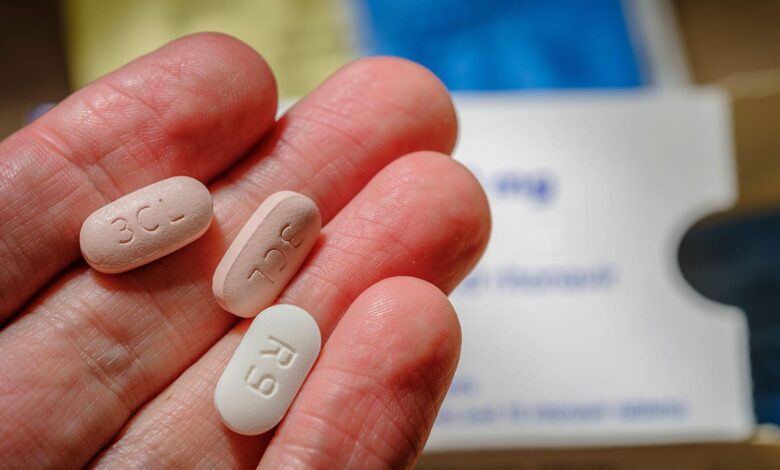Why Aren’t More Doctors Prescribing Paxlovid to High-Risk Patients?

Recent evidence is piling up that many people at high risk for severe COVID-19 don’t receive nirmatrelvir/ritonavir (Paxlovid) — or any outpatient antiviral treatment — when diagnosed with a SARS-CoV-2 infection. MedPage Today looked at new studies and talked to experts to find out why.
In a new observational study, people on Medicare who were at highest risk for severe COVID-19 were actually less likely to receive outpatient antiviral treatments, such as nirmatrelvir/ritonavir, than Medicare beneficiaries at lower risk. For example, individuals 90 years and older were 36% less likely to receive the drugs compared with those ages 65 to 69 years (adjusted odds ratio [aOR] 0.64, 95% CI 0.62-0.65).
Moreover, when researchers performed a simulation analysis of data, they found that reallocation of nirmatrelvir/ritonavir according to patient risk could have prevented about 10,300 hospitalizations and 16,500 deaths in 2022 alone, Michael Barnett, MD, from the Harvard T.H. Chan School of Public Health in Boston, and colleagues reported in JAMA Health Forum.
Especially concerning was the finding that people in nursing homes were less likely to receive any COVID-19 treatment compared to people living in the community (aOR 0.78, 95% CI 0.75-0.81), despite the fact that nursing home residents were more likely to be tested for COVID-19 or have a COVID-19 related healthcare visit, the authors wrote.
Differences could not be explained by contraindications to nirmatrelvir/ritonavir, drug-drug interactions, access to ambulatory visits, variation in COVID-19 testing, or geographic variation. Given that nirmatrelvir/ritonavir treatment was available at no cost in 2022 when the study was conducted, cost barriers did not explain the findings, Barnett told MedPage Today.
In a separate study, appearing in Morbidity and Mortality Weekly, 80% of immunosuppressed patients with mild-to-moderate COVID-19 were not offered any antiviral medication, even though those patients were at high risk for severe disease.
For almost 50% of those patients, the main reason given was that the patient had “mild symptoms,” Paul Monach, MD, PhD, of the VA Boston Healthcare System, and colleagues reported. About one in five of these patients were not offered antiviral treatment because more than 5 days had elapsed since symptom onset. Just 5.7% were not prescribed an antiviral medication because of potential contraindications. Notably, 20% of patients were offered antiviral medication, but refused treatment.
So, What Is Going on With Paxlovid?
It’s, well, complicated.
‘The mechanisms underlying low and disparate use of COVID-19 therapies are unclear,” Barnett and colleagues wrote in their study. “Possible factors include differential access to clinicians willing to prescribe antivirals or administer antibodies, concerns about drug interactions, patient preferences, the timing of when patients sought care, … or numerous nonclinical barriers, such as poverty and structural racism.”
Social media and forum sites are replete with anecdotal tales of people being unable to get a prescription for nirmatrelvir/ritonavir when they test positive.
MedPage Today contacted several physicians to find out why they are hesitant to prescribe nirmatrelvir/ritonavir. None responded to a request for an interview.
The new icing on the cake is that Pfizer recently raised the price for a single course of the drug from the roughly $530 the U.S. government paid during the public health emergency to to nearly $1,400. Pfizer did set up the patient assistance program PAXCESS to help patients obtain nirmatrelvir/ritonavir, and Medicare or Medicaid recipients and the uninsured will be able to access nirmatrelvir/ritonavir at no cost through the end of 2024. Nevertheless, out-of-pocket costs for some privately insured patients are likely to be prohibitive.
Politics and Misinformation
“I worry that a lot of the difference in Paxlovid [uptake] is that there’s a large education and awareness gap where a lot of people don’t know what Paxlovid is or are skeptical of it,” Barnett told MedPage Today. In his experience, most patients who ask for nirmatrelvir/ritonavir are well-educated and white, he said.
Medical misinformation, politicization of COVID-19, and distrust in the medical establishment and pharmaceutical industry have likely contributed to poor uptake of antiviral medications for COVID-19 among patients and healthcare providers alike, Suraj Saggar, DO, chief of infectious diseases at Holy Name Medical Center in Teaneck, New Jersey, told MedPage Today.
But not every patient who requests nirmatrelvir/ritonavir is at high risk for severe COVID-19. “I spend a significant amount of time telling people why they don’t need it as well as telling people why they do,” Saggar said. “It’s become harder as this pandemic has evolved, where it’s not a one-size-fits-all.” He said he considers the patient’s age and comorbidities, but also whether they live with people who are at high risk for severe COVID-19.
Even Doctors Struggle to Get Treatment
It’s notable that even physicians report difficulties getting nirmatrelvir/ritonavir for themselves or high-risk family members. Christina Mangurian, MD, vice dean of Faculty and Academic Affairs at University of California San Francisco (UCSF) School of Medicine, wrote in JAMA about her ordeal obtaining nirmatrelvir/ritonavir for her aging parents after they contracted COVID-19. The replies to her article — many of them from physicians — were telling:
“We had a similar experience with my husband, who takes an anticoagulant and a statin, is 87, and is in great shape,” wrote one physician in the comments section of Mangurian’s article. “Six calls to the supposed COVID team for his medical group. Finally, a refusal to prescribe.”
“I was recently shocked when 3 of my cousins, both in their 80s and one on immunosuppressants … were recommended not to take Paxlovid,” another physician commented. “One was told by an internist that it was too dangerous a medicine and not worth the risk because of drug interactions.”
“The article struck a nerve,” Mangurian told MedPage Today. “I think why it got so much attention is because so many people had encountered similar problems.” In fact, in response to her article, leaders at UCSF sent out information to all patients confirming that nirmatrelvir/ritonavir was available and how to access it, she said.
“I don’t think the issue is so much that there are bad doctors. I think that doctors aren’t given the tools they need” to confidently prescribe it, Mangurian, an implementation scientist, explained. One step would be to make sure clinical decision support tools or flow sheets are updated to include nirmatrelvir/ritonavir prescribing alerts and ways to manage drug-drug interactions, she suggested.
In fact, drug-drug interactions do remain a key stumbling block for physicians when considering nirmatrelvir/ritonavir. Often, patients at high risk for severe COVID-19 are on the very medications that have known interactions with nirmatrelvir/ritonavir. “As a clinician, I don’t think that’s a good excuse because there’s a very tiny number of medications that interact with Paxlovid that are harmful to stop for a week,” Barnett told MedPage Today. “It’s a much better risk-benefit ratio for someone to stop their statin and take Paxlovid while they’re sick.”
Telehealth: Good for Healthcare Providers, Not So Good for Older Adults
Another key problem is that face-to-face primary care appointments are hard to come by within the 5-day timeframe required from symptom onset to treatment initiation with nirmatrelvir/ritonavir. Although telehealth programs are convenient for healthcare providers, they aren’t always the best solution for older or disabled individuals, since they often encounter obstacles in navigating online platforms. “Older patients a lot of times can’t figure out how to use an iPhone, can’t use a smartphone or a tablet, can’t get on Doximity or other third-party apps,” Saggar said. “Lower income patients maybe don’t have wifi.”
Current Recommendations Still Stand
Virologists and infectious disease specialists continue to recommend nirmatrelvir/ritonavir for high-risk patients, such as people over 65, and those with obesity, hypertension, diabetes, and chronic lung or heart disease. “I think it would be reasonable for people over 75, even without comorbidities, to take Paxlovid, primarily because age is associated with a lessening of the immune response,” Paul Offit, MD, a virology expert at the Children’s Hospital of Philadelphia, told MedPage Today.
“There is no evidence that Paxlovid is not active against the new variants,” said Robert Schooley, MD, an infectious disease specialist at University of California San Diego. Because new strains of SARS-CoV-2 may be less pathogenic and more people are vaccinated or have had COVID-19, “fewer people are hospitalized these days so the difference Paxlovid would make in terms of hospitalization would be less apparent,” he added.
-
![author['full_name']](https://assets.medpagetoday.net/media/images/author/2N5A0622_180.jpg)
Katherine Kahn is a staff writer at MedPage Today, covering the infectious diseases beat. She has been a medical writer for over 15 years.
-
![author['full_name']](https://clf1.medpagetoday.com/media/images/author/cherylClark_188_2.jpeg)
Cheryl Clark has been a medical & science journalist for more than three decades.
Disclosures
The JAMA Health Forum study was funded by a grant from the National Institute on Aging (NIA). Barnett reported grants from NIA during the conduct of the study and personal fees from California Department of Health Services. Co-authors reported relationships with Moderna, GRAIL, and the Analysis Group, as well as a number of government and nonprofit entities.
Monach reported institutional support from Gilead Sciences and consulting fees from HI-Bio. One co-author reported institutional support from Gilead Sciences.
Saggar is on the speaker’s board of Abbvie and has consulted for Gilead Sciences.
Schooley has consulted for Abbvie.
Mangurian and Offit reported no conflicts of interest.
Primary Source
JAMA Health Forum
Source Reference: Wilcock AD, et al “Clinical risk and outpatient therapy utilization for COVID-19 in the Medicare population” JAMA Health Forum 2024; DOI: 10.1001/jamahealthforum.2023.5044.
Secondary Source
Morbidity and Mortality Weekly Report
Source Reference: Monach PA, et al “Underuse of antiviral drugs to prevent progression to severe COVID-19 — Veterans Health Administration, March-September 2022” MMWR Morb Mortal Wkly Rep 2024; DOI: 10.15585/mmwr.mm7303a2.


